#University of Arizona Press
Photo
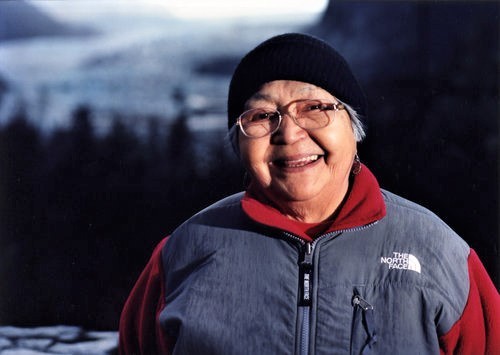




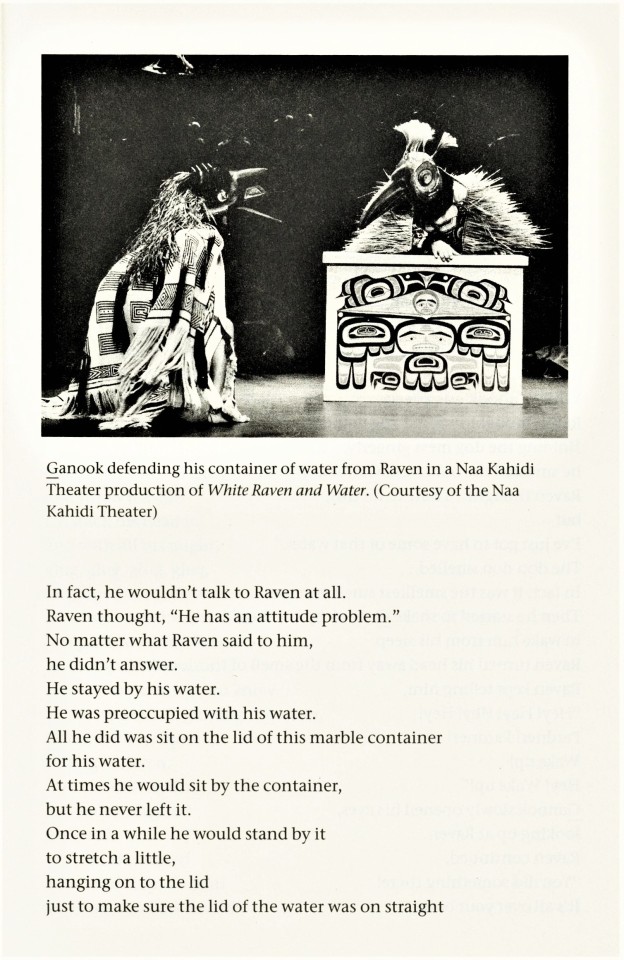

Native American/First Nations Woman Writer of the Week
NORA MARKS DAUENHAUER
Continuing on our trek through what remains of March, I offer you another Indigenous woman writer, Nora Marks Keixwnéi Dauenhauer (1927-2017), a Tlingit writer from Juneau, Alaska. Born in Juneau, Dauenhauer grew up there as well as in Hoonah, Alaska with a father who was a fisherman and carver, and a mother who was a beader. Dauenhauer lived at times with her parents on a fishing boat and in seasonal camps. Being a member of the Tlingit tribe, her first language was Łingít, and she did not learn English until she was eight.
Following her mother in the Tlingit matrilineal system, she was a member of the Raven moiety of the Tlingit nation, of the Yakutat Lukaax̱.ádi (Sockeye Salmon) clan, of the Shaka Hít or Canoe Prow House, from Alsek River. She was chosen as clan co-leader of Lukaax̱.ádi (Sockeye Salmon) in 1986 and as trustee of the Raven House and other clan property. She was then given the title Naa Tláa (Clan Mother) in 2010, becoming the ceremonial leader of the clan.
Dauenhauer earned a BA in anthropology from Alaska Methodist University in Anchorage. In the early 1970s, she married poet and Tlingit scholar Richard Dauenhauer and together they made significant contributions to preserve the Tlingit oral traditions in their Classics of Tlingit Oral Literature book series. Nora Dauenhauer became a Tlingit language researcher for the Native Language Center at the University of Alaska, Fairbanks from 1972-1973, and then became the principal researcher in language and cultural studies at the Sealaska Heritage Foundation in Juneau from 1983-1997.
On the subject of preserving the Tlingit oral tradition and its importance, Dauenhaur said:
People are now beginning to take action for language and cultural survival, and my work is to help provide inspiration and tools for this through my writing.
Dauenhauer had several accomplishments, including being named the 1980 Humanist of the Year by the Alaska Humanities Forum. Together, the Dauenhauers were awarded the Alaska Governor’s Award for the Arts, two American Book Awards, and a Before Columbus Foundation American Book Award. In 2005, Nora Dauenhauer was the recipient of the Community Spirit Award from the First People’s Fund.
As a poet, Nora Dauenhauer published two collections, one of which we hold in Special Collections, Life Woven With Song, published by the University of Arizona Press in 2000 (the other is The Droning Shaman, Black Current Press, 1989). This book recreates the oral tradition of the Tlingit people through written language in a variety of literary forms, and records memories of Dauenhauer’s heritage from old relatives and Tlingit elders, to trolling for salmon and preparing food in the dryfish camps and making a living by working in canneries.
Author Photo is by Hulleah Tsinhnahjinnie
See other writers we have featured in Native American/First Nations Woman Writer of the Week.
View other posts from our Native American Literature Collection.
-- Elizabeth V., Special Collections Undergraduate Writing Intern
#Native American/First Nations Woman Writer of the Week#women's history month#Native Americans#Native American writers#Native American women writers#Nora Marks Dauenhauer#Richard Dauenhauer#Tlingit#Life Woven With Song#University of Arizona Press#Alaskan writers#poets#poetry#Elizabeth V.#Native American Literature Collection
136 notes
·
View notes
Text
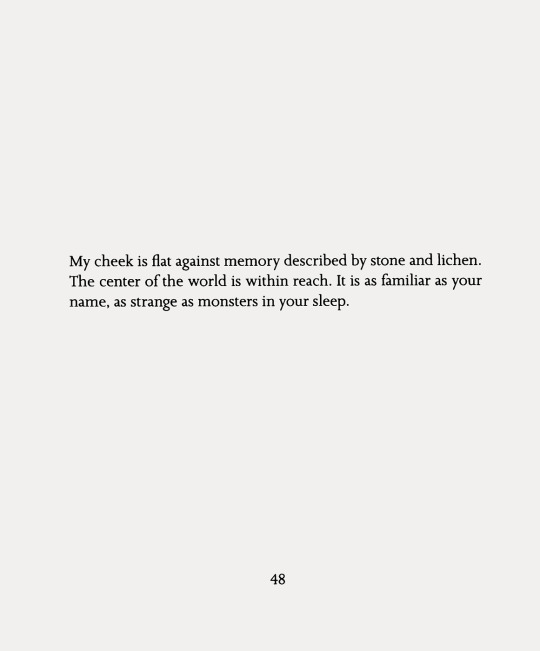
Joy Harjo, Secrets from the Center of the World, Photographs by Stephen Strom, Sun Tracks and The University of Arizona Press, Tucson, AZ, 1989, pp. 48-49
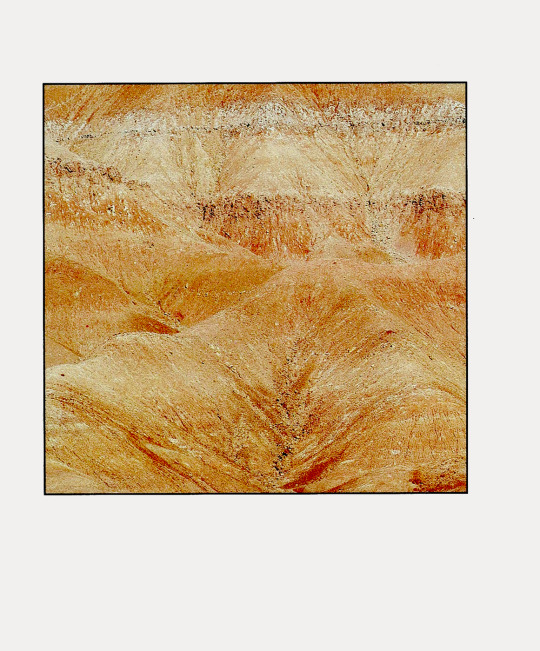
My cheek is flat against memory described by stone and lichen. The center of the world is within reach. It is as familiar as your name, as strange as monsters in your sleep.
#graphic design#art#poetry#photography#book#joy harjo#stephen strom#sun tracks#the university of arizona press#1980s
39 notes
·
View notes
Text
After being told that a Final Four would bring trillions to the area, the city of Glendale accepts that they made almost nothing off it
Around 2010, the NCAA told Final Four host cities to generally expect an economic boost between $70 and $200 million. Last year, Glendale, Arizona was told that it could make $270 million dollars in economic impact from hosting a Final Four event in 2024. This year, some groups mentioned the possibility of the state making an impact between $250-$300 million from the Final Four. Others believed…

View On WordPress
#Arizona#Billions#Dave Berri#Economic Benefits#Economic Impact#Final Four#Glendale#Hotel Tax#Kevin Phelps#NCAA#NFL#Phoenix#Sales Tax#Southern Utah University#Sports Economist#State Press#Super Bowl#Tax Revenues#Trillions#Utah
0 notes
Text
The Best News of Last Week
1. Arizona governor Ok's over the counter birth control
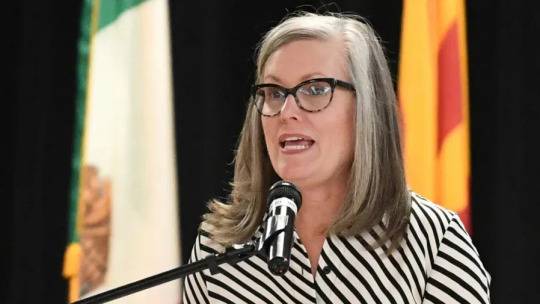
Arizona Gov. Katie Hobbs (D) has expanded access to over-the-counter birth control that will “soon be available to Arizonans,” according to a press release.
Arizonans 18 and older will soon be able to go to their local pharmacy and purchase oral contraceptives without a doctor’s prescription.
2. ‘Great news’: EU hails discovery of massive phosphate rock deposit in Norway

A massive underground deposit of high-grade phosphate rock in Norway, pitched as the world’s largest, is big enough to satisfy world demand for fertilisers, solar panels and electric car batteries over the next 50 years, according to the company exploiting the resource. About 90% of the world’s mined phosphate rock is used in agriculture for the production of phosphorous for the fertiliser industry, for which there is currently no substitute.
3. U.S. Is Destroying the Last of Its Once-Vast Chemical Weapons Arsenal

Decades behind its initial schedule, the dangerous job of eliminating the world’s only remaining declared stockpile of lethal chemical munitions will be completed as soon as Friday.
4. Chinese scientists create edible food packaging to replace plastic

By incorporating certain soy proteins into the structure, Chinese University of Hong Kong scientists successfully created edible food packaging.
5. World's 1st 'tooth regrowth' medicine moves toward clinical trials in Japan

A Japanese research team is making progress on the development of a groundbreaking medication that may allow people to grow new teeth, with clinical trials set to begin in July 2024. The tooth regrowth medicine is intended for people who lack a full set of adult teeth due to congenital factors.
6. No Longer Endangered: The Bald Eagle is an Icon of the ESA

When the Endangered Species Act (ESA) was enacted in 1973, bald eagle population numbers across the country showed that the species was close to disappearing. Before the ESA, in the 1950s and ‘60s, eagles were shot routinely despite the protection. The ESA listing helped bring public attention to the issue.
Through the early 1970s and into the early ‘80s, numbers increased gradually. Then, as you got into the ‘90s, there was still gradual growth. From the late ‘90s into the 2000s, the population really exploded. There was a doubling rate of every several years or so for a while.
7. Deforestation in Brazil's Amazon drops 34% in first half 2023

Deforestation in Brazil's Amazon fell 34% in the first half of 2023, preliminary government data showed on Thursday, hitting its lowest level in four years as President Luiz Inacio Lula da Silva institutes tougher environmental policies.
Data produced by Brazil's national space research agency Inpe indicated that 2,649 square km (1,023 square miles) of rainforest were cleared in the region in the half year, the lowest for the period since 2019.
----
That's it for this week :)
This newsletter will always be free. If you liked this post you can support me with a small kofi donation:
Support this newsletter ❤️
Also don’t forget to reblog.
5K notes
·
View notes
Text
Keith is good at compartmentalizing. Always has been. Sure, he’s not always great at emotional regulation, but when the serious shit pops up? Under lock and key it goes, to be brought out only late at night when he’s feeling sorry for himself and wants to make things worse.
(Okay. His coping mechanisms could be better.)
(He’s doing his best, alright? Life is hard.)
But sometimes, his compartments get too damn full. His brain just gets so cluttered with shit that he has no boxes left to shove the hard shit into, and he just has to handle it. It always sucks. It’s always a million times worse than his late night freak-outs.
This one in particular, though?
This one takes the cake.
If one were to steal a probably-dusty manila file from the desk one of the social workers for the State of Arizona, labelled ‘Keith Akira Kogane’, they would see, clearly labelled, a section called ‘ORPHAN’. Under that section would be a subheading — ‘Death of Father’. If this person were to read further, they would discover that officially, according to the Arizona State Reporting District, Texas Kogane died tragically trying to put out a house fire in the line of duty. His son waited three days for him to return home before walking to the fire station and demanding to see his father, and was then swiftly picked up and brought to the Grass Hills Region Arizona State Social Services Office, and assigned a group home after speaking to a child psychologist and social worker.
That story is, almost entirely, false.
Keith’s father did die tragically and heroically in the line of duty. It was a particularly brutal house fire, and Texas did manage to save the family that was trapped, at the cost of his own life.
What the story fails to mention is that the house was, specifically, home to Keith’s closest friend at the time. The file also fails to mention that Keith’s father often worked long hours, and so Keith frequently spent time at that friend’s house.
The article fails, perhaps most ardently, to mention that the day of the fateful fire, Keith was present at the house. The day of the fateful fire, Keith watched the house go up in flames faster than he could comprehend. The day of the fateful fire, Keith cried for his father, curled up in the corner of a room with a wet t-shit over his face, soot covering his hair and smoke lining his lungs. The day of the fateful fire, Texas Kogane kicked open the door behind which Keith was trapped in a blaze of glory, scooping up his small-for-his-age son in his arms and rushing him safely out of the house, hugging him tightly and pressing the briefest of kisses to his dirty hair before rushing back into the house to save the rest of the family that was trapped inside.
The file fails to mention that on the day of the fateful fire, Keith watched his infallible father sprint into the house, and never make it back out.
Keith doesn’t much like fire. The file doesn’t mention that, either. (Keith knows. He stole it, one day, and read it. It had to be locked away in a little box in his head, too.)
.
.
.
Space happens so goddamn quickly.
One day he’s chilling in his stupid shack with a couple cool lizards, dicking around on his hover bike and tracking some weird energy, and the next he’s flying through a real-life wormhole on a sentient lion piloted by a boy with startlingly striking brown eyes that he kind of vaguely remembers if he squints. And then that wormhole leads him to a real-life alien castle, and real-life aliens (he knew it, Keith knew it, he was right all along, his Pa was right all along, they both were —) and he’s informed by a real-life alien princess that he’s the Paladin of the Red Lion, the Universe’s Guardian of Fire.
And oh, does the bitter taste of irony flood his tongue.
He swallows quickly, desperately shoving the box closed, adding as many mental strips of duct tape that he can. He forces his face into a mask of stoicism (practiced to perfection from years of home after home after home) and prays that no one was looking closely enough to see the lick of terror flash through his eyes.
He’s lucky, that way. No one ever is.
He keeps that dangerous box closed as he frees a petulant mecha lion from a Galra ship that he navigates too easily (yet another box), keeps it closed as he argues and fights with the boy with pretty brown eyes (rival, his rival — his shadow?), keeps it closed as he fights a dictator and the dictator’s general and holds the hand of the same boy who smiles and says they make a great team. Keith holds that box shut with both hands as he nearly fights an alien who tries to take his knife at a space mall and trains with the man who’s like a brother to him, along with a brand-new team he’s supposed to trust with his deepest secrets.
Keith squeezes that box shut with every ounce of mental strain that he has, and then some. He grits his teeth and tells himself that fire is good and warm and powerful and life-ending and frightening and —
His bayard unlocks a blazing canon, flames sweeping out and brightly illuminating the stifling emptiness of space, burning everything in its path, and the box bursts open.
“Holy shit, Keith!”
“Yo! Is that a flamethrower?”
“Excellent work, kiddo.”
“‘About time you caught up, Mullet.”
The words are distorted, far away. His team’s transparent excitement fans the flames wreaking havoc on every carefully sealed box in his head, turning strict lines to ash and reducing his head to embers. His skin burns as bright as a sun, sweat dripping down his forehead, and smoke fills his lungs until he’s coughing, wheezing, choking to death —
He has no idea how the rest of the training goes. He has no idea how he manages to keep upright, with his vision swimming in and out and his hands slipping off the controls. He has no idea even how he manages to stay alive with flames licking him from the inside, burning him to a crisp from his bones out to his skin. He has no idea how he manages to land Red in her hangar, how he keeps from turning to ash in the pilot��s seat. How he manages to rip off his seatbelt with hands that have turned to burnt coal and rush down the ramp on legs that are simmering flames.
“Ay, Greñudo! What’s keeping you? You’ve been locked in here for half an hour, Shiro’s got a firecracker up his ass worrying — Jesus Christ, Keith, what’s wrong?”
What’s wrong? What’s wrong? Can’t he see? Can’t he feel the flames that lick up Keith’s skin and burn him up? Can’t he feel the heat of Keith’s destruction? Do his eyes not burn from the brightness of the fire?
How is Keith alive? How is he standing when his lungs have stopped working, cooked in his chest? Keith tries to inflate them, to force them open with clean air, but it doesn’t work, they don’t work, the smoke is choking him and killing him and there’s no Pa to save him —
A shock of freezing cold gently touches his neck, his cheek. A breath is startled into his lungs.
They work again.
“Smoke’s cleared,” Keith croaks, because it must be, now that he can feel the cool air trickling down his throat again. He takes large, gulping breaths, taking in as much air as he can before the smoke returns and he suffocates again.
“That’s it,” Lance soothes. “In and out, starboy. Your lungs are clear, yeah? There’s no fire, no smoke. Feel that air. In and out.” The coolness on Keith’s cheek spreads, following the shape of his cheekbone, back and forth, again and again.
Lance’s thumb.
His hands, on Keith’s cheek and on his neck.
“Y’r hands’re cold.”
Lance cracks a smile. “Iron deficiency.”
“Oh. You should —” Keith’s breath shudders as it regulates. He realises his hands are clenched on Lance’s wrist. “—you should eat more red meat.”
What is he even talking about?
Lance smile gets a little wider. It softens his eyes again, deep and brown and dark, like they looked after Sendak. Keith likes it when he smiles at him.
“I’m a vegetarian. That’s cute of you, by the way.”
“Oh. I didn’t know that.” It takes Keith a moment to process Lance’s other sentence.
This time, his face gets hot for a whole different reason.
“I didn’t — I didn’t mean —”
“Hey. Cool it,” Lance orders, tapping Keith between the eyes. His lips are still curved into a smirk. “You’re coming down from a gnarly-ass panic attack. The last thing you need is to freak out again. Keep matching my breathing, okay? You’re doing great.”
“Never thought I’d hear you say that,” Keith manages between his still-heavy breaths. The redness has yet to recede from his face, but he’s pleased to hear Lance’s quiet laughter.
“Yeah, yeah, Greñudo. Treasure it, ‘cause I’m not saying it again.”
Keith swallows, tightening his grip on Lance’s wrist. Greñudo. That nickname again, but it’s not malicious. Teasing. It’s the softest he’s ever heard Lance say it.
“What’s that mean? Grendo?”
“‘Grendo’ means nothing,” Lance replies, amused. “But Greñudo means disheveled. Messy. Slang for —” he tugs gently on the hair at the back of Keith’s neck — “mullet, like this travesty.”
“Oh.”
“Yeah, ‘oh’.”
Keith slowly moves his hand up Lance’s arm, from his wrist to his elbow. He stops when Lance’s breath hitches, simply resting on the smooth skin, but continues on when Lance doesn’t stop him, slowly tracing the lean muscles and bony joints down Lance’s bicep, his shoulder, his side, settling at his waist. Lance’s hands have stilled, but remain on his cheek and neck, cradling his face.
“You channeling your Gomez, huh, Mullet?” Lance asks, but his voice isn’t it’s usual barbed wire, but soft; quiet and stuttering.
“I liked Starboy better,” Keith says quietly. All the burning pain has quietly slipped away from his body, leaving only a soft, tender glow behind, like the amber embers from the campfires he and Pa used to have on late nights.
It’s not scary. It’s — warm, even. Comforting.
“I bet you do.”
Keith says nothing. He stays right where he is, pressed to Lance in three different places, the coolness of Lance’s skin pulling the burning heat from Keith’s bones.
“Are you always this cold?” Keith asks. It’s not what he wants to say — what does he want to say? — but it’s what he can manage, standing so closely to Lance, the quiet scent of his floral shampoo pushing out the smell of smoke caught in Keith’s nose.
Lance hums. “You always feel like you’re running a fever?”
“Yes. Worse since I started piloting Red.”
“Guess I’ll have to help you cool down, then.”
“Guess so.” Unbidden, a smirk fights its way on Keith’s face. “That would make us a pretty good team, huh?”
It takes Lance a moment to react, but then he does, pulling away with a groan and a smack to the back of Keith’s head.
“There you go,” he admonishes, “bringing up fake bonding moments are ruining the real one we were having. Can’t let things go, huh?”
Keith shrugs, but the smile stays out on his face. “Can’t let your lying ass keep getting away with it.”
“Yeah, yeah,” Lance says, rolling his eyes. He hesitates a moment, then darts forward and grabs Keith’s hand, yanking him towards the door as he power walks out of Red’s hangar. Keith stumbles after him.
“Let’s go,” Lance says, once Keith’s got his balance. He glances back at Keith, small smile showing the barest hint of teeth. “Starboy.”
#i haven’t written keith angst in a minute to please take the fruits of my labour#‘labour’ being me being bored as hell in church#vld#voltron#keith#keith kogane#lance#lance mcclain#klance#pre klance#soft klance#early s1 voltron#keith angst#traumatised keith#keith & lance#pining keith#pining lance#pining klance#brown-eyed lance#panic attack#panic attacks#my writing#fic#longpost#flirting
502 notes
·
View notes
Note
hi! any reading you'd rec on bio politics\necro politics? i've recently gotten curious about the concepts so forgive if this is vague or not specific lol. tyy in advance ! hope ur day is good
so, the standard recs you will usually see for getting a theoretical foundation here are:
Foucault's 1978–9 lecture series at the Collège de France, "The Birth of biopolitics", and his 1975–6 series, "Society must be defended" (there are print series of his lectures) (<-these are honestly overrated as sources imho b/c foucault never fully developed these concepts. i would read lecture 11 from the 75–6 series if you absolutely feel you need some foucault, and then skip to whatever else seems interesting)
Achille Mbembe's Necropolitics (2019)
Jasbir Puar's The Right to Maim: Debility, Capacity, Disability (2017)
there are also lots and lots and lots of books that use concepts of bio/necropolitics in their historical and/or political arguments. some i've enjoyed include:
Joshua Cole, The Power of Large Numbers: Population, Politics, and Gender in Nineteenth-Century France (2018: Cornell University Press)
Daniel Nemser, Infrastructures of Race: Concentration and Biopolitics in Colonial Mexico (2017: University of Texas Press)
Andrew Aisenberg, Contagion: Disease, Government, and the "Social Question" in Nineteenth-Century France (1999)
Mie Nakachi, Replacing the Dead: The Politics of Reproduction in the Postwar Soviet Union (2021: Oxford University Press)
Banu Subramaniam, Holy Science: The Biopolitics of Hindu Nationalism (2019: University of Washington Press)
Kyla Schuller, The Biopolitics of Feeling: Race, Sex, and Science in the Nineteenth Century (2017: Duke University Press)
Michela Marcatelli, Naturalizing Inequality: Water, Race, and Biopolitics in South Africa (2021: University of Arizona Press)
Ellen Amster, Medicine and the saints: science, Islam, and the colonial encounter in Morocco, 1877-1956 (2013: University of Texas Press)
Ron Broglio, Beasts of Burden: Biopolitics, Labor, and Animal Life in British Romanticism (2017: SUNY Press) (<-doubles as an introduction into why the 'animal turn' has been such a hot topic historiographically in the past 5 or 6 years)
James Duncan, In the Shadows of the Tropics: Climate, Race and Biopower in Nineteenth Century Ceylon (2007: Ashgate)
René Dietrich & Kerstin Knopf (Eds.), Biopolitics, geopolitics, life: settler states and indigenous presence (2023) (<-haven't read this yet! some of these essays look very promising)
#book recs#biopolitics#there is also a very interesting chapter in nükhet varlık's book on ottoman empire & plague that makes an argument for usage of#the biopolitics framework centuries prior to the 'classic' 19thc case study. however varlık's book is very long and mostly not about that
121 notes
·
View notes
Text
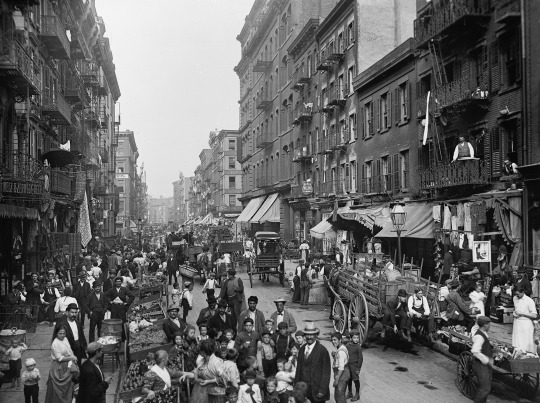
How Italians Became ‘White’
Congress envisioned a white, Protestant and culturally homogeneous America when it declared in 1790 that only “free white persons, who have, or shall migrate into the United States” were eligible to become naturalized citizens. The calculus of racism underwent swift revision when waves of culturally diverse immigrants from the far corners of Europe changed the face of the country.
As the historian Matthew Frye Jacobson shows in his immigrant history “Whiteness of a Different Color,” the surge of newcomers engendered a national panic and led Americans to adopt a more restrictive, politicized view of how whiteness was to be allocated. Journalists, politicians, social scientists and immigration officials embraced the habit, separating ostensibly white Europeans into “races.” Some were designated “whiter” — and more worthy of citizenship — than others, while some were ranked as too close to blackness to be socially redeemable. The story of how Italian immigrants went from racialized pariah status in the 19th century to white Americans in good standing in the 20th offers a window onto the alchemy through which race is constructed in the United States, and how racial hierarchies can sometimes change.
Darker skinned southern Italians endured the penalties of blackness on both sides of the Atlantic. In Italy, Northerners had long held that Southerners — particularly Sicilians — were an “uncivilized” and racially inferior people, too obviously African to be part of Europe.
Racist dogma about Southern Italians found fertile soil in the United States. As the historian Jennifer Guglielmo writes, the newcomers encountered waves of books, magazines and newspapers that “bombarded Americans with images of Italians as racially suspect.” They were sometimes shut out of schools, movie houses and labor unions, or consigned to church pews set aside for black people. They were described in the press as “swarthy,” “kinky haired” members of a criminal race and derided in the streets with epithets like “dago,” “guinea” — a term of derision applied to enslaved Africans and their descendants — and more familiarly racist insults like “white nigger” and “nigger wop.”

The penalties of blackness went well beyond name-calling in the apartheid South. Italians who had come to the country as “free white persons” were often marked as black because they accepted “black” jobs in the Louisiana sugar fields or because they chose to live among African-Americans. This left them vulnerable to marauding mobs like the ones that hanged, shot, dismembered or burned alive thousands of black men, women and children across the South.
The federal holiday honoring the Italian explorer Christopher Columbus — celebrated on Monday — was central to the process through which Italian-Americans were fully ratified as white during the 20th century. The rationale for the holiday was steeped in myth, and allowed Italian-Americans to write a laudatory portrait of themselves into the civic record.
Few who march in Columbus Day parades or recount the tale of Columbus’s voyage from Europe to the New World are aware of how the holiday came about or that President Benjamin Harrison proclaimed it as a one-time national celebration in 1892 — in the wake of a bloody New Orleans lynching that took the lives of 11 Italian immigrants. The proclamation was part of a broader attempt to quiet outrage among Italian-Americans, and a diplomatic blowup over the murders that brought Italy and the United States to the brink of war.
Historians have recently showed that America’s dishonorable response to this barbaric event was partly conditioned by racist stereotypes about Italians promulgated in Northern newspapers like The Times. A striking analysis by Charles Seguin, a sociologist at Pennsylvania State University, and Sabrina Nardin, a doctoral student at the University of Arizona, shows that the protests lodged by the Italian government inspired something that had failed to coalesce around the brave African-American newspaper editor and anti-lynching campaigner Ida B. Wells — a broad anti-lynching effort.
A Black ‘Brute’ Lynched
The lynchings of Italians came at a time when newspapers in the South had established the gory convention of advertising the far more numerous public murders of African-Americans in advance — to attract large crowds — and justifying the killings by labeling the victims “brutes,” “fiends,” “ravishers,” “born criminals” or “troublesome Negroes.” Even high-minded news organizations that claimed to abhor the practice legitimized lynching by trafficking in racist stereotypes about its victims.
As Mr. Seguin recently showed, many Northern newspapers were “just as complicit” in justifying mob violence as their Southern counterparts. For its part, The Times made repeated use of the headline “A Brutal Negro Lynched,” presuming the victims’ guilt and branding them as congenital criminals. Lynchings of black men in the South were often based on fabricated accusations of sexual assault. As the Equal Justice Initiative explained in its 2015 report on lynching in America, a rape charge could occur in the absence of an actual victim and might arise from minor violations of the social code — like complimenting a white woman on her appearance or even bumping into her on the street.
The Times was not owned by the family that controls it today when it dismissed Ida B. Wells as a “slanderous and nasty-minded mulattress” for rightly describing rape allegations as “a thread bare lie” that Southerners used against black men who had consensual sexual relationships with white women. Nevertheless, as a Times editorialist of nearly 30 years standing — and a student of the institution’s history — I am outraged and appalled by the nakedly racist treatment my 19th-century predecessors displayed in writing about African-Americans and Italian immigrants.
When Wells took her anti-lynching campaign to England in the 1890s, Times editors rebuked her for representing “black brutes” abroad in an editorial that joked about what they described as “the practice of roasting Negro ravishers alive and boring out their eyes with red-hot pokers.” The editorial slandered African-Americans generally, referring to rape as “a crime to which Negroes are particularly prone.” The Times editors may have lodged objections to lynching — but they did so in a rhetoric firmly rooted in white supremacy.
‘Assassins by Nature’
Italian immigrants were welcomed into Louisiana after the Civil War, when the planter class was in desperate need of cheap labor to replace newly emancipated black people, who were leaving backbreaking jobs in the fields for more gainful employment.
These Italians seemed at first to be the answer to both the labor shortage and the increasingly pressing quest for settlers who would support white domination in the emerging Jim Crow state. Louisiana’s romance with Italian labor began to sour when the new immigrants balked at low wages and dismal working conditions.
The newcomers also chose to live together in Italian neighborhoods, where they spoke their native tongue, preserved Italian customs and developed successful businesses that catered to African-Americans, with whom they fraternized and intermarried. In time, this proximity to blackness would lead white Southerners to view Sicilians, in particular, as not fully white and to see them as eligible for persecution — including lynching — that had customarily been imposed on African-Americans.

https://static01.nyt.com/newsgraphics/2019/10/10/srw1011-staplesgallery/4792c59ca6f516c487b724c1c77fd4899b3050d3/photo_cat.jpg
Nevertheless, as the historian Jessica Barbata Jackson showed recently in the journal Louisiana History, Italian newcomers were still well thought of in New Orleans in the 1870s when negative stereotypes were being established in the Northern press.
The Times, for instance, described them as bandits and members of the criminal classes who were “wretchedly poor and unskilled,” “starving and wholly destitute.” The stereotype about inborn criminality is plainly evident in an 1874 story about Italian immigrants seeking vaccinations that refers to one immigrant as a “burly fellow, whose appearance was like that of the traditional brigand of the Abruzzi.”
A Times story in 1880 described immigrants, including Italians, as “links in a descending chain of evolution.” These characterizations reached a defamatory crescendo in an 1882 editorial that appeared under the headline “Our Future Citizens.” The editors wrote:
“There has never been since New York was founded so low and ignorant a class among the immigrants who poured in here as the Southern Italians who have been crowding our docks during the past year.”
The editors reserved their worst invective for Italian immigrant children, whom they described as “utterly unfit — ragged, filthy, and verminous as they were — to be placed in the public primary schools among the decent children of American mechanics.”
The racist myth that African-Americans and Sicilians were both innately criminal drove an 1887 Times story about a lynching victim in Mississippi whose name was given as “Dago Joe” — “dago” being a slur directed at Italian and Spanish-speaking immigrants. The victim was described as a “half breed” who “was the son of a Sicilian father and a mulatto mother, and had the worst characteristics of both races in his makeup. He was cunning, treacherous and cruel, and was regarded in the community where he lived as an assassin by nature.”
Sicilians as ‘Rattlesnakes’
The carnage in New Orleans was set in motion in the fall of 1890, when the city’s popular police chief, David Hennessy, was assassinated on his way home one evening. Hennessy had no shortage of enemies. The historian John V. Baiamonte Jr. writes that he had once been tried for murder in connection with the killing of a professional rival. He is also said to have been involved in a feud between two Italian businessmen. On the strength of a clearly suspect witness who claimed to hear Mr. Hennessy say that “dagoes” had shot him, the city charged 19 Italians with complicity in the chief’s murder.
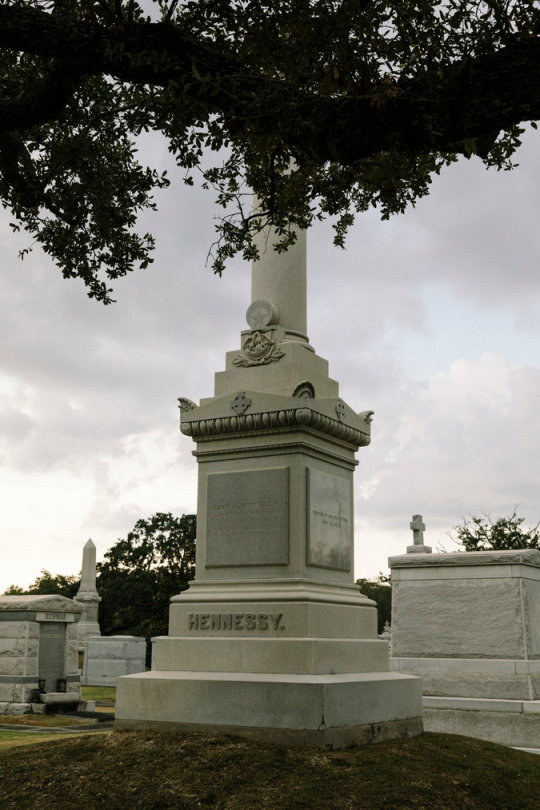
The monument to David Hennessy rises above nearly all
the other tombs in Metairie Cemetery in New Orleans.William Widmer for The New York Times
That the evidence was distressingly weak was evident from the verdicts that were swiftly handed down: Of the first nine to be tried, six were acquitted; three others were granted mistrials. The leaders of the mob that then went after them advertised their plans in advance, knowing full well that the city’s elites — who coveted the businesses the Italians had built or hated the Italians for fraternizing with African-Americans — would never seek justice for the dead. After the lynching, a grand jury investigation pronounced the killings praiseworthy, turning that inquiry into what the historian Barbara Botein describes as “possibly one of the greatest whitewashes in American history.”
The blood of the New Orleans victims was scarcely dry when The Times published a cheerleading news story — “Chief Hennessy Avenged: Eleven of his Italian Assassins Lynched by a Mob” — that reveled in the bloody details. It reported that the mob had consisted “mostly of the best element” of New Orleans society. The following day, a scabrous Times editorial justified the lynching — and dehumanized the dead, with by-now-familiar racist stereotypes.
“These sneaking and cowardly Sicilians,” the editors wrote, “the descendants of bandits and assassins, who have transported to this country the lawless passions, the cutthroat practices … are to us a pest without mitigations. Our own rattlesnakes are as good citizens as they. Our own murderers are men of feeling and nobility compared to them.” The editors concluded of the lynching that it would be difficult to find “one individual who would confess that privately he deplores it very much.”

Lynchers in 1891 storming the New Orleans city jail, where they killed 11 Italian-Americans accused in the fatal shooting of Chief Hennessy.Italian Tribune
President Harrison would have ignored the New Orleans carnage had the victims been black. But the Italian government made that impossible. It broke off diplomatic relations and demanded an indemnity that the Harrison administration paid. Harrison even called on Congress in his 1891 State of the Union to protect foreign nationals — though not black Americans — from mob violence.
Harrison’s Columbus Day proclamation in 1892 opened the door for Italian-Americans to write themselves into the American origin story, in a fashion that piled myth upon myth. As the historian Danielle Battisti shows in “Whom We Shall Welcome,” they rewrote history by casting Columbus as “the first immigrant” — even though he never set foot in North America and never immigrated anywhere (except possibly to Spain), and even though the United States did not exist as a nation during his 15th-century voyage. The mythologizing, carried out over many decades, granted Italian-Americans “a formative role in the nation-building narrative.” It also tied Italian-Americans closely to the paternalistic assertion, still heard today, that Columbus “discovered” a continent that was already inhabited by Native Americans.
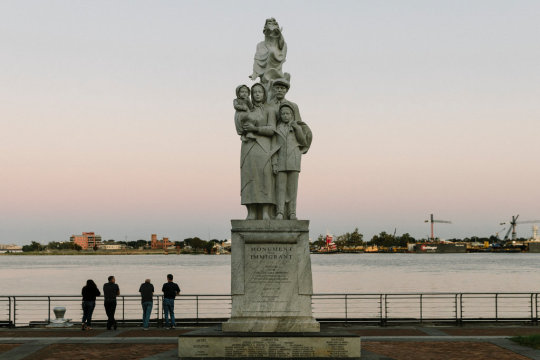
The “Monument to the Immigrant,” commissioned by the Italian American Marching Club of New Orleans, stands along the Mississippi River in Woldenberg Park.William Widmer for The New York Times
But in the late 19th century, the full-blown Columbus myth was yet to come. The New Orleans lynching solidified a defamatory view of Italians generally, and Sicilians in particular, as irredeemable criminals who represented a danger to the nation. The influential anti-immigrant racist Representative Henry Cabot Lodge of Massachusetts, soon to join the United States Senate, quickly appropriated the event. He argued that a lack of confidence in juries, not mob violence, had been the real problem in New Orleans. “Lawlessness and lynching are evil things,” he wrote, “but a popular belief that juries cannot be trusted is even worse.”
Facts aside, Lodge argued, beliefs about immigrants were in themselves sufficient to warrant higher barriers to immigration. Congress ratified that notion during the 1920s, curtailing Italian immigration on racial grounds, even though Italians were legally white, with all of the rights whiteness entailed.
The Italian-Americans who labored in the campaign that overturned racist immigration restrictions in 1965 used the romantic fictions built up around Columbus to political advantage. This shows yet again how racial categories that people mistakenly view as matters of biology grow out of highly politicized myth making.

#italians#sicily italy#wop#african#afrakan#kemetic dreams#brownskin#afrakans#africans#brown skin#congress#new orleans lynching#new orleans#massachusetts#european#europeans#how italians became white#becoming white#white people#white#white culture#western europe
104 notes
·
View notes
Note
Could I request an Arizona Robbins imagine in which the two are together but they’re arguing over what route to go in for a surgery and during the surgery they bicker and soon they make up? After the surgery and then it’s fluffy?

Author Note:
Finally another story from me in the universe of Grey's Anatomy. I haven't written for these characters in a long time so sorry if they don't do justice to the real character on the show, I need to get back into it.
---
"Bookeh, pass me the pincer grip, please" ordered Arizona and looked concernedly at the monitor to which her little eight year old patient was connected in order to keep an eye on his vital signs during the procedure. "Pulse fluctuates violently, blood pressure is low but in the range."
Her gaze turned back onto the small and petite body as soon as she was informed of the health status and took the requested item between her outstretched fingers. "You seem nervous, we should have taken my route. It would have been safer!" you spoke slightly annoyed and pansy into the room, unsure whether the little boy would survive the operation with such a huge intervention and the associated risks with it.
"Then instead of three small punctures that the laparoscopy needs, he would have a huge scar that will forever remind him of this!" she answered seriously and continued to concentrate on the imaging procedures, which thanks to the camera, showed the whole abdomen.
Before you could counter anything against her choice, she invited you to look at the monitors as well and learn from it. "What can you see?" she asked to cover her nervousness about the information she had just discovered.
"The intestines are quite convoluted" you explained.
"I agree. That´s why I am going to try to unravel the intestines with the switch. What else can you see?" she continues to ask and began to press around the individual pieces of intestines with the forceps. "The rectum already looks necrotic" you answered confidently and a small grin escaped your lips.
Now she had to go your way; Arizona could not continue removing the already dead tissue with a laparoscopy. "Enough with the teaching, ´zona. We need to expand the operation and cut him open as soon as possibly."
The blonde bit her lip and stared silently at the monitor. She did not like to admit that you were right, but denying it was not in the cards at that moment. "I can see that, Y/n." While she carefully pulled the instruments out of the boy´s abdomen and sewed up each abdominal wound that was left behind, you took the scalpel and drew a long line from the navel to below the waist.
"I told you from the start that we should do it this way, why can´t you just listen to me?"
Sighing, your girlfriend pulled the stitches tighter and her hands clenched on the sewing scissors she was holding. "Because I am the head of pediatric surgery and I usually always contest the procedure I think is right!"
"Can you at least trust me for once and listen to me?" You brought me into this operation so I think I have a minimal right of choice as well." Your voice is suddenly muted by the irregular beeping of the monitor, allowing no time to bicker as you freeze for a moment in shock. Both heads looked up from their work and announced synchronously, "Pulse has dropped to 52, blood pressure has fallen into the red area."
While you tried helplessly to locate the source of the young man´s sudden debilitating state, Arizona stood paralyzed in her place and watched you frantically work the open body in on the operating table.
"What happened?" she asked in disbelief, seconds later, beginning to break out her rigid state as she mentally prepares for the worst. "He´s bleeding. Above the necrotic tissue, the intestinal wall is so thin that it tears open as soon as I touch it."
You tried desperately to stop the bleeding that was obliterating all your vision. The suction that Bookeh held in the open abdominal cavity, trying to suck up the blood to give you a better view, also failed due to the amount of blood. "I need help here, four hands are still better than two."
Your girlfriend quickly moved to the opposite side of you and grabbed the tools needed to help you find and stop the bleeding. But she, too, was struggling and was sure they had to do more than that. Arizona noticed through a minimal insight that both simple sutures and the tissue had not chance to hold or recover; everything had to go.
"Hemicolectomy. We need to remove the part that´s impermeable or it may rupture. Rose, page Doctor Bailey, we need assistance here" the head of pediatric surgery was slightly overwhelmed and annoyed, so she pronounced the sentences slightly mad.
---
After a few hours and the active support from Bailey, the little boy survived. Although he had a bumpy and difficult healing path ahead of him, the most important thing was that he was still breathing and had a long life ahead of him.
"Fortunately, everything went well" Arizona whispered and you could hear relief in her hesitant voice. Your gaze turned to her briefly and you nodded before looking at the sink again, not a word leaving your lips.
You stood in the washroom of your used operation room and kept silent to each other until the blonde spoke up. "Maybe next time I should step back and listen to you when it comes to a surgical route" she admitted, looking down at her hands. "It´s not that I don´t trust you, I just like to always be right and do everything right, you know?"
You nodded.
"Arizona, it´s okay. I am not mad at you." you said mournfully and simply, drying your hands before moving behind her and burying your face in the crook of her shoulder. "I know that you only want the best for the little ones on the operating table, I can understand that."
Your hands slid down her sides and she giggled before placing her hands on your forearms and wrapping them around her middle. Soft, light and warm kisses breathed on her thin and ticklish skin between head and shoulder, she leaned her head back into her neck and enjoyed the closeness and warmth of you.
"I am sorry."
#Arizona robbins#arizona robbins imagines#arizona robbins x reader#arizona robbins imagine#arizona robbins#arizona robbins x you#greys anatomy imagine#greys abc#greys anatomy imagines#greysanatomy#greys anatomy#fanfic#fanfiction#fanfics#oneshot#imagine#imagines#x reader
158 notes
·
View notes
Text
Moonlight, A Pink Scarf Universe Story
A/N: So, I was challenged to do a prompt game, and since I'm desperately trying to fight my perfectionism and become more consistent with my writing, I took on the challenge and wrote this dramatic little heartbreaker this afternoon just under the wire like crazy person. I hope you enjoy this short, barely edited extension of Pink Scarf. It takes place a few months after the Christmas 1960 flashback in Part 16. (Please go easy on me because it is literally the least revised/edited thing I've ever put out and I desperately hope you like it 💗)
Thanks to @thatbanditqueen @whositmcwhatsit @ellie-24 @from-memphis-with-love @be-my-ally and @vintageshanny for challenging me to do this even when I wanted to convince myself I couldn't do it.
Prompt: “Do you mind? I came here to get away from other people.”
Rating: PG-13 || Word Count: 2k
TW: Miscarriage, medical trauma, angst, depression, intrusive thoughts
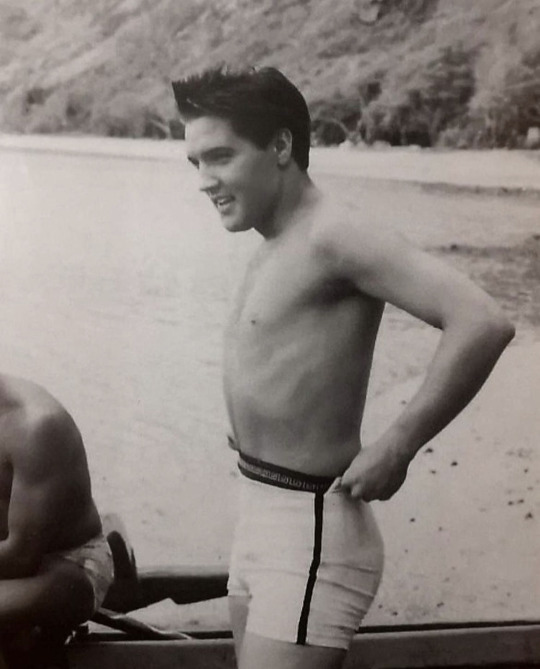
Moonlight
Hawaii, March 1961
The room is pressing in on you with all these jovial faces, celebrating in paradise after Elvis’ successful benefit concert for the Pearl Harbor Arizona Memorial. You should be celebrating with them.
You wish you could.
Instead, you are fighting back tears, praying that no one notices your frantic need to escape the otherwise wonderful atmosphere.
Elvis decided to bring you all along for a month-long vacation of sorts as he films his newest picture, Blue Hawaii, and performs the benefit concert to raise money for the Memorial. Y’all need some rest and recreation, he’d said joyfully, his eyes falling on you in particular, and how could you possibly refuse? It genuinely seemed like a great idea, even though he’d technically be working, and so would Jack by extension, but a change of scenery would do you some good after everything that's happened. Maybe you and Jack could reconnect on the tropical getaway, you’d thought.
But so much had happened since you agreed to this trip.
No one knew, of course. Not Jack. Not your family. Certainly not Elvis. You had made sure of it because you couldn’t stand the hopeful looks that would have come with the news, and the inevitable pity that would’ve come after.
The humid Hawaiian air coupled with the room full of people makes you feel as though you can’t draw a full breath. Lightheaded, you push your way through the throng of people filling the lavish home that had been rented for the express purpose of Elvis being able to stay comfortable and private during his shooting schedule. It’s an incredible relief once you burst out onto the patio, then stumble down the sandy path to the breathtaking beach.
Surprisingly, there’s not a soul on the moonlit sand, and for that you are eternally grateful because you cannot hold back your choked sobs any longer. The ebb and flow of the surf crashes over your crying, and you very much wish you could drown your sorrows in the vastness of the ocean in front of you.
Getting pregnant again was not even something you thought was possible. It was cruel, you thought, that you’d nearly made it 12 weeks this time before your body decided that it would reject the baby. You had just started to really, truly think it would be different this time. You were getting ready to tell Jack. You were almost, almost happy.
Even more cruel was that it was almost a year to the day of you bleeding out on the floor of the Rollerdome.
In some ways you’d been thankful that everyone had been so busy preparing for the trip that no one paid much mind to the fact that you locked yourself in the bathroom for hours, silently sobbing through the cramping and the bleeding and the clotting. You’d known then it was too late.
Tears stream down your cheeks as you hug your knees and begin to rock in the soft sand. At least it’s beautiful here, you think absently, trying to soothe yourself.
You’d taken to bed, claiming a bout of food poisoning, and no one was the wiser, being as excited and busy as they were. Not one of them seemed to bat an eye or think it was strange that no one else had any symptoms. A small part of you breaks a little at that, feeling more alone in the world than you ever have. But another part figures it’s just as well. Perhaps it is a blessing that no one knew of your latest failure. Honestly, you so were disappointed in yourself over it all you didn’t think could handle that disappointment from others, especially Jack.
Two days after losing your second child, you’d gotten on the plane to come here, spending hours upon hours with a false smile spread across your features. Maybe if you smiled enough you’d start to believe it. After all, you were in paradise with Elvis Presley. Millions would kill to be where you are.
Stop feeling sorry for yourself. Be grateful for what you have, you berate yourself, as you have more than once on the trip. Not even the stunning beauty of the island has been able to push your thoughts away from your loss, your seemingly unending sorrow permeating even the most beautiful of sunsets.
The only moment when you’d felt truly free of it had been watching Elvis’ concert earlier. He was so mesmerizing that it was impossible not to be caught up in his performance. You’d been happy for the momentary distraction, for the way your heart had flip flopped a little at the sight of him in his element, sweaty and feeding off the crowd effortlessly. It was easy to get swept away amongst all the screaming fans, to understand why the man you’d called a friend was the sensation that he was, and to forget everything but him for just a little while.
But by the time this stupid afterparty rolled around, the dark cloud that followed you this past year found you once more, and you were honestly too tired to push it away any longer.
You can’t help thinking how you should have an infant with you now, that in a kinder world you’d have your baby and perhaps another on the way. But the world is not always kind. Instead you are empty and alone.
So you find yourself sobbing on a gorgeous beach in Hawaii in the middle of the night, finally allowing yourself to sit in the grief of your misfortune.
You’re not sure how long you’ve been out here before his tall, lanky frame towers over you, interrupting your grief so suddenly that you find yourself livid.
You furiously swipe the tears from your cheeks, knowing your makeup is smearing but not having the energy or wherewithal to care. “Do you mind? I came here to get away from other people,” you snap.
Even in the darkness, you see how taken aback he is by your anger, his pretty face shifting from surprise to annoyance.
“Is that any way to talk to the guy who brought you to this beautiful place?” Elvis says lightly, but you can hear the edge in his tone. He’s not used to people speaking like that to him, least of all you.
Honestly, you’re not really sure when you last spoke to him at all. Since your strange little embrace on Christmas, he’d taken to avoiding you most of the time, yet again. Coupled with how empty you felt from your miscarriages, the fact that your friend had been so obviously (and seemingly purposefully) absent from your life in the past year was heartbreaking in its own right. It was like a slap in the face on top of your other failures, so far from the unbridled excitement he’d shown when he’d discovered your first pregnancy before anyone else had. So far from the love and care and attention he’d given you before.
You’re not sure you really understood how much it bothered you until this very moment. His sudden entitlement for attention and gratefulness makes your blood boil.
You pop up off the sand, pushing your windblown hair out of your face. “Oh, yes, how sorry I am that not every one of my thoughts is about your stunning generosity, your majesty,” you say sarcastically, viciously, before turning to stomp down the beach away from him. You’ve never, ever spoken to him this way, to anyone this way, but the darkness of your sorrow has flared into something else entirely, this blistering anger threatening to swallow you whole and take Elvis with you.
“Excuse me?” he says indignantly, grasping your arm and whipping you back to face him. His eyes flash in the darkness, both in confusion and with warning.
“Don’t touch me!” you spit, ripping your arm out of his grasp.
“What has gotten into you? What the hell did I do?” he shouts, his voice raising over the surf.
“Not everything is about you, Elvis!” you scream back at him.
For a second, it looks as if you’ve slapped him across the face, with the way his eyes widen in surprise.
You pause for a moment, breath heaving, before continuing. “And since when do you even care what’s going on with me?”
“W-What are ya talkin’ about? O-Of course I care! I-I-I brought ya on this trip, d-d-didn’t I?” The emotions fly over his features so quickly it makes it too hard to discern what he’s thinking, but his stutter belies his frustration.
“You’ve barely talked to me in a year, Elvis. Can’t imagine why I’d think you care,” you scoff.
His eyes go dark, then blank, that Hollywood mask of his sliding over his features. “You’re nuts! You’re just bein’ crazy…” he starts, shaking his head.
“Yeah, I must be. I must be crazy thinkin’ my friend might give me the time of day after…everything that’s happened,” you hiss back.
Elvis blinks, his long lashes fanning over his cheekbones. You don’t know if he’s finally done the math in his head, figuring out that you nearly died and lost your baby almost exactly a year ago. Or maybe, like he’d somehow known you were pregnant the first time, he gleans some supernatural understanding of what might be happening with you now. Either way, his gaze softens dramatically.
“Oh, honey,” he says, “I didn’t—”
Yeah, you didn’t, you think bitterly. He didn’t do a lot of things. He wasn’t even there after you almost died. But you suppose being a star of his caliber didn’t leave him much time to slum it with you, not anymore. And why would he want to? Not when you’ve been depressed and have already failed at the one thing you felt you were created to do as a woman.
“Just leave me alone, E. You’ve gotten good at that,” you mutter, angry tears filling your eyes, turning away from him to stare out into the churning waves.
You can’t look at him. But you feel the heat of his eyes, nonetheless.
“Don’t do that, y/n,” he says quietly.
“Don’t do what? Speak the truth?”
“You don’t know what you’re talkin’ about,” he growls.
He doesn’t get to be angry. Not about this.
“No, you don’t know, Elvis. You have no idea what it’s been like, you couldn’t. And you haven’t even tried…” you trail off, shaking your head.
You know that’s a lie. Whatever had happened between you on Christmas had been something, as much as you’d tried to deny it and forget his strange behavior. Perhaps that had been him trying.
Suddenly, more than anything, you want him to pull you into his arms like he did that night three months ago. You want him to comfort you and let you sob against his chest, to inhale the distinct scent of him as the heat of his lean body presses into yours. You want the desperate tension that is climbing between you to shatter you and make you forget that the past year had ever happened.
But instead of drawing you close, you watch him put distance between you. You feel as he fortifies that invisible wall he’s built between you this past year. It’s only in the depths of his churning cobalt eyes that you see something akin to apology, along with something deeper that neither of you truly wants to unpack.
Then, Elvis shutters that churning away, his fist clenching and unclenching in time with his jaw. “Yeah, I guess not. I’ll leave ya alone, then.” And he turns and walks away.
Oh god. You feel as though you’ve been hit in the chest, pain radiating inexplicably through your torso, the claws of his dismissal ripping through your insides. You don’t know why. You wanted him to go, and he went.
You sink down into the sand, fresh tears pooling in your eyes, and you wish more than anything that the ocean would just swallow you whole.
Taglist:
@atombombbibunny @yesimwriting @uselessbutinteresting @mirandastuckinthe80s @dark-as-love
@domaniquessidehoe @im-lame-irl @allybrooke05 @hangmanswhore
@jazmin2211 @kvcssghbjbcd @coldonexx @dudinhahoff @whatstruthgottodowithit @tiredbuthappy @amiets2 @saintmagx
@kvcssghbjbcd @butlersluvbot @babydollie43 @vainbimbo @meladollsims @wstelandbaby @dre6ming @normatural @ash-omalley @xcallmetaniax @galvz-42 @thejezebel @fullmetal-falcon @robinismywife @dre6ming @seaweedbrain00 @amiets2 @mslizziesblog @heisatroubleinapinksuit @calusussss @dont-feel-so-good-peter @rainydayz101 @pizzaisrelationshipgoals
@liaaacantwrite @kittenlittle24 @kaitaesupremacy @butler-trouble @eliseinmemphis @russian-soft-bitch @tattywood
@sassanoe @re3kin @thella @suspiciousmidge @hiddlepiddlediddlewiddle @carolinesbookworld @juggernort @aesthetic-lyss @stitchattacks @donnamarie23 @ab4eva
@fic-over-cannon @lacyluver @littlebitofgreen @paigevis @godlypresley @bugg06 @xhannahbananax03 @artlover8992
@18lkpeters @frozenhuntress67 @girlblogger2002 @kendralavon7 @elvisgf @misspresley @ohjustpeachyachy1 @whositmcwhatsit @be-my-ally @precious-little-scoundrellittle-scoundrel @vintageshannygeshanny @from-memphis-with-lovephis-with-love @prompted-wordsmithmith @ellie-2424 @thatbanditqueennditqueen @stylespresleyhearted @elv1s-is-pretty @crash-and-cure
#prompt game#pink scarf#Moonlight: A Pink Scarf Universe Story#💗🧣💗#A Pink Scarf Universe Story#Moonlight#elvis presley#elvis#if you’re looking for trouble#you came to the right place#elvis x reader#elvis presley x reader#austin butler elvis#elvis 2022#austin!elvis x reader#austin!elvis imagine#elvis imagine#elvis smut#elvis x you#missmaywemeetagain#madisyn may#elvis fanfic#elvis presley fic#bad girls club#tw: miscarriage
101 notes
·
View notes
Text

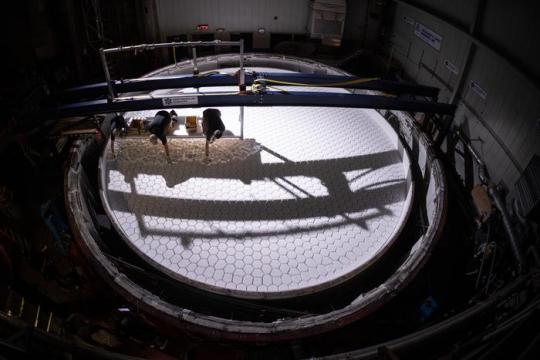
The Giant Magellan Telescope’s final mirror fabrication begins
The Giant Magellan Telescope begins the four-year process to fabricate and polish its seventh and final primary mirror, the last required to complete the telescope’s 368 square meter light collecting surface, the world’s largest and most challenging optics ever produced. Together, the mirrors will collect more light than any other telescope in existence, allowing humanity to unlock the secrets of the Universe by providing detailed chemical analyses of celestial objects and their origin.
Last week, the University of Arizona Richard F. Caris Mirror Lab closed the lid on nearly 20 tons of the purest optical glass inside a one-of-a-kind oven housed beneath the stands of the Arizona Wildcats Football Stadium. The spinning oven will heat the glass to 1,165°C so as it melts, it is forced outward to form the mirror’s curved paraboloid surface. Measuring 8.4-meters in diameter—about two stories tall when standing on edge—the mirror will cool over the next three months before moving into the polishing stage.
At 50 million times more powerful than the human eye, “the telescope will make history through its future discoveries,” shares Buell Jannuzi, Principal Investigator for the fabrication of the Giant Magellan Telescope primary mirror segments, Director of Steward Observatory, and Head of the Department of Astronomy at the University of Arizona. “We are thrilled to be closing in on another milestone in the fabrication of the Giant Magellan Telescope.”
The most recently completed primary mirror is ready for integration into a giant support system prototype early next year for final optical performance testing. This testing will serve as the dress rehearsal for all seven primary mirrors. Once assembled, all seven mirrors will work in concert as one monolithic 25.4-meter mirror—a diameter equal to the length of a full-grown blue whale—resulting in up to 200 times the sensitivity and four times the image resolution of today’s most advanced space telescopes.
The Giant Magellan Telescope will be the first extremely large telescope to complete its primary mirror array. With strong operational infrastructure completed at the telescope site in Chile, focused manufacturing is taking place on the telescope’s critical subsystem before starting on the enclosure.
“We are in an important stage of fabrication, with much of the manufacturing happening in the United States,” shares Robert Shelton, President of the Giant Magellan Telescope.
The 39-meter-tall telescope structure is being manufactured with 2,100 tons of American steel at a newly-built manufacturing facility in Rockford, Illinois, and fabrication of the telescope’s first of seven adaptive secondary mirrors—a one for one pair with each of the seven primary mirrors—is underway.
“The combination of light-gathering power, efficiency, and image resolution will enable us to make new discoveries across all fields of astronomy,” shares Rebecca Bernstein, Chief Scientist for the Giant Magellan Telescope. “We will have a unique combination of capabilities for studying planets at high spatial and spectral resolution, both of which are key to determining if a planet has a rocky composition like our Earth, if it contains liquid water, and if its atmosphere contains the right combination of molecules to indicate the presence of life.”
The telescope is expected to see first light by the end of the decade, and will work to answer some of humanity’s most pressing questions: Where did we come from? Are we alone in the Universe?
TOP IMAGE....University of Arizona Richard F. Caris Mirror Lab staff members placing nearly 20 tons of Ohara E6 low expansion glass into a mold for casting the Giant Magellan Telescope's seventh primary mirror segment, September 2023. CREDIT Damien Jemison, Giant Magellan Telescope – GMTO Corporation
LOWER IMAGE....University of Arizona Richard F. Caris Mirror Lab staff members placing chunks of Ohara E6 low expansion glass into a mold for casting the Giant Magellan Telescope's seventh primary mirror segment, September 2023. CREDIT Damien Jemison, Giant Magellan Telescope – GMTO Corporation
35 notes
·
View notes
Text
After the Supreme Court overturned Roe v. Wade in June 2022, 14 states have imposed near-total abortion bans. (Arizona may soon join them.) While all of these states include exemptions to save the life of the mother, the language is inherently vague. The abortion bans typically allow for emergency abortions to prevent "serious risk of substantial and irreversible impairment of a major bodily function" or "serious, permanent impairment of a life-sustaining organ." But the laws do not address "expectations regarding the most common obstetric complications that can lead to late-stage pregnancy loss, such as previable premature rupture of membranes, excessive bleeding, gestational hypertension, preeclampsia, or placental abruption."
The American College of Obstetricians and Gynecologists says that it is critical that hospitals "provide guidance that permits treatment to the full extent of applicable state law and support and defend their clinicians when they provide care to patients."
In many hospitals, that is not happening. The result is that pregnant women are showing up at emergency rooms and are not receiving the care they need. An Associated Press report last week, based on federal documents, found that "[c]omplaints that pregnant women were turned away from U.S. emergency rooms spiked in 2022 after the U.S. Supreme Court overturned Roe v. Wade." Sara Rosenbaum, a professor of health law at George Washington University, says that pregnant patients have “become radioactive to emergency departments.”
10 notes
·
View notes
Text



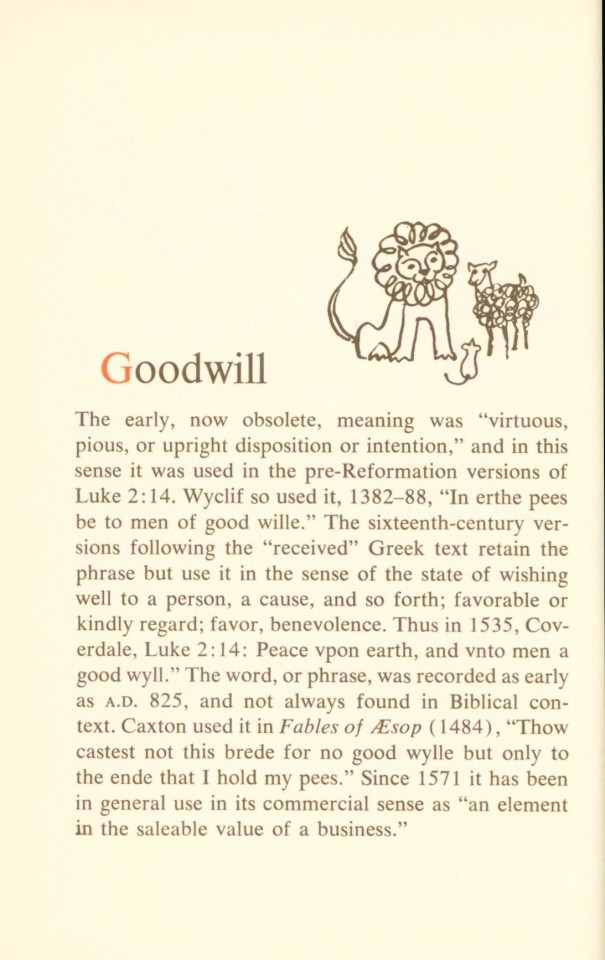



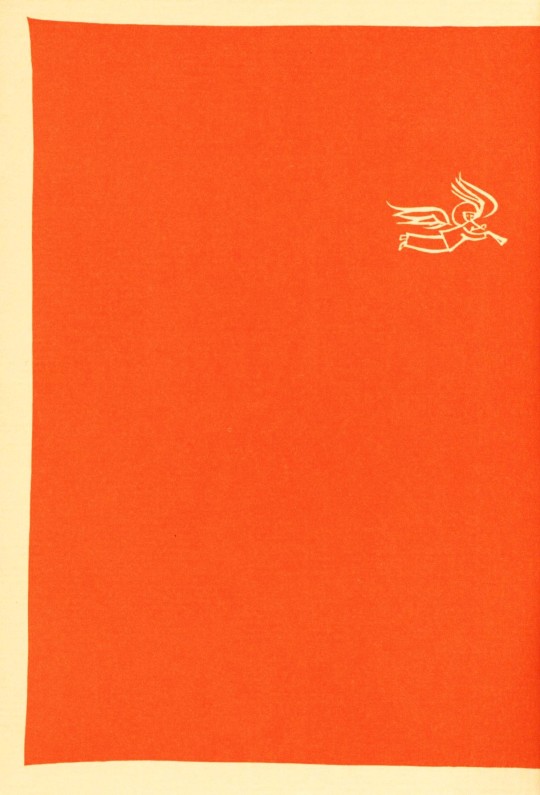
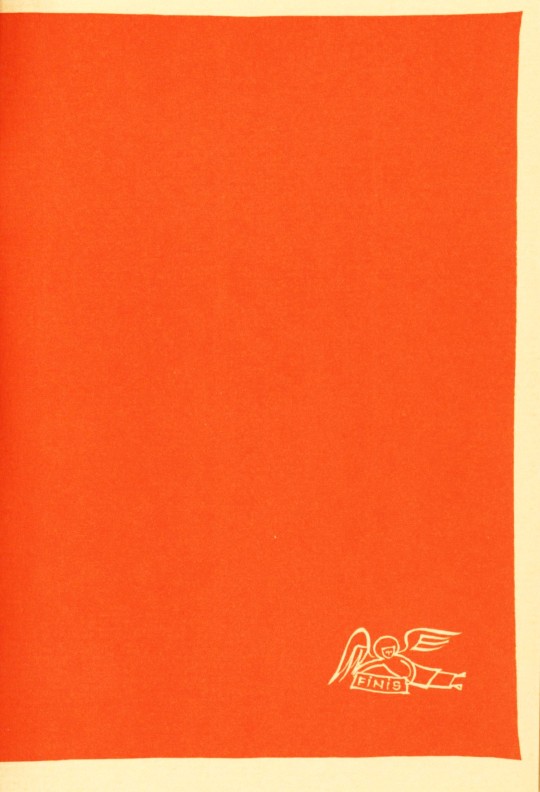
It’s Fine Press Friday!
In the spirit of Christmas’s arrival in three days, we present a small Christmas-themed book entitled An Alphabet of Christmas Words, published in 1966. The book is a dictionary of holiday terms, with corresponding illustrations. Entries were selected and edited from the Oxford English Dictionary by American writer Helen McKelvey Oakley (1906-2003), who explains that her “interest [in this project] lies in seeing how The Dictionary treats [each term].” The accompanying illustrations are by Ursula Suess (b. 1924), a graphic designer, calligrapher, and artist. Most recently, her art was shown in a 2022 solo exhibition at the Tubac Center of the Arts in Tubac, Arizona.

An Alphabet of Christmas Words was offset printed in Times Roman on Mohawk Superfine Text paper by Hallmark Lithographers Inc. in an edition of 360 copies, published by the Oxford University Press and designed by Ursula Suess and the press's art director and vice president John Begg (1903-1974). Also included with this book are two small season’s greetings cards from the press; one has Begg’s name printed on it and the other has “from Ursel and Mutti” inscribed in black ink.


View more Fine Press Friday Posts.
– Sarah S., Special Collections Graduate Intern
#Fine Press Friday#fine press fridays#fine press printing#fine press books#An Alphabet of Christmas Words#Christmas#oxford dictionary#oxford english dictionary#helen mckelvey oakley#ursula suess#John Begg#Times Roman#Mohawk superfine paper#offset printing#Hallmark Lithographers#typophiles#alphabet#Sarah S.
57 notes
·
View notes
Text

Joy Harjo, Secrets from the Center of the World, Photographs by Stephen Strom, Sun Tracks and The University of Arizona Press, Tucson, AZ, 1989




#graphic design#art#poetry#photography#book#cover#book cover#joy harjo#stephen strom#sun tracks#the university of arizona press#1980s
40 notes
·
View notes
Text
In the Sonoran Desert of Arizona and Northwest Mexico, many long-time residents claim that with the onset of the summer’s monsoonal rains, a feeling of elation and relief comes as fragrances fill the air in a way that makes it seem as though “the desert smells like rain.”
For decades, geologists, botanists, atmospheric scientists, and ecologists have debated the causes and triggers of this euphoric sensation. Some scientists have focused on fragrances emitted by cryptogamic or biological soil crusts during rains, while other have focused on the terpentine-like smell of the creosote bush known in Sonoran Spanish as hediondilla, ‘the little stinker.” But now two scientists from the University of Arizona [...] propose a novel, but more comprehensive answer:
The Sonoran Desert flora is one of the richest in the world in plants that emit fragrant volatile oils, and many of those fragrances confer stress-reducing health benefits to humans, wildlife, and the plants themselves. [...] [T]he biogenic volatile organic compounds (BVOCs) [...] evolved to protect plants from damaging solar radiation, heat waves, drought stress and herbivores [...].
---
Initially, desert scientists focused their attention on an earthy fragrance called petrichor that is emitted from the biological soil crusts by a compound called geosmin. Geosmin underlies the earthy taste of beetroots, with notes like eucalyptus, cinnamon, and cloves and can be detected by the human nose at concentrations as low as 400 parts per trillion. It is secreted from dead microbes in the soil crusts of many different kinds of landscapes but is now known to be emitted only sporadically in Sonoran Desert soils after summer rains.
---
Ecologists who studied the North American deserts then tried to explain this phenomenon through a “single cause” focus on one of the most common plants in the Mohave, Sonoran and Chihuahuan desert: Larrea tridentata, known in English as the creosote-bush. Curiously, it emits more than 35 distinct terpenes and other BVOCs, some of which (like trans-caryophyllene) are generated by an endophytic fungus growing “hidden” within the plant’s tissues. With the onset of monsoons, the high density of shrubs forming “creosote flats” emit terpentine-like fragrances (like isoprene) as potent as any botanical emissions into the atmosphere. Nevertheless, this dominant plant is by no means the only major emitter of BVOCs that give Sonoran Desert habitats their renowned fragrances.
---
The new research from the Desert Laboratory on Tumamoc Hill has found more than 60 species of 178 native plants in the ancient ironwood-giant cactus forests of the Sonoran Desert which emit fragrant biogenic volatile organic compounds (BVOCs) immediately before, during and after rainstorms. [...] From these desert species, more than 115 volatile oils have been identified, as high a number as is known from any biogeographic region in the world. In particular, the researchers Gary Nabhan, Eric Dougherty and Tammi Hartung identified more than 60 potent fragrances emitted from the foliage and flowers of desert plants during the monsoonal rainy season of the iconic “Sonoran Desert summer.”
The authors hypothesize that a “suite” of 15 particular BVOCs emitted from this diversity of desert plants during the monsoons may function synergistically to generate tangible health benefits. [...].Their accumulation in the atmosphere immediately above desert vegetation can reduce exposure to damaging solar radiation in ways that protect the desert plants themselves, the wildlife which use them as food and shelter, and the humans who dwell among them.
---
Text by: Gary Paul Nabhan. “Why Does the Desert Smell Like Rain? New UA Research Suggests the Diverse “Osmocosm” of the Sonoran Desert.” Published under the “News” section online at University of Arizona Press. 13 April 2022.
177 notes
·
View notes
Text
Biden to Designate Monument Near Grand Canyon, Preventing Uranium Mining
Uranium extraction had already been restricted in the area, which Native tribes consider sacred, but the moratorium was set to expire in 2032. Mr. Biden’s designation will make it permanent.
(The New York Times, 8/8/23) President Biden will designate nearly a million acres of land near the Grand Canyon as a new national monument on Tuesday to protect the area from uranium mining, administration officials confirmed on Monday.
Mr. Biden’s visit to Arizona is part of a nationwide blitz by the White House to translate key policy victories to voters — including a law he signed last year to inject $370 billion in tax incentives into wind, solar and other renewable energy — as the 2024 campaign ramps up. Senior cabinet officials are also touring the country this week, highlighting his domestic agenda.
During his first stop of a three-state tour, Mr. Biden will announce that he is creating a national monument — the fifth such designation of his presidency — in an area sacred to Native American tribes, administration officials told reporters on Monday.
“The mining is off limits for future development in that area,” Ali Zaidi, Mr. Biden’s national climate adviser, told reporters on Air Force One. “It’s focused on preserving the historical resources” in the area.
Native tribes and environmental groups have long lobbied for the government to permanently protect the area around the Grand Canyon from uranium mining, which they say would damage the Colorado River watershed as well as areas with great cultural meaning for Native Americans.
Under the proposed designation, all new uranium mining will be blocked. Uranium mining has already been restricted in the area in question since 2012, but that Obama-era moratorium was set to expire in 2032. Mr. Biden’s designation would make the conditions permanent.
Mr. Biden’s visit to Arizona was also an effort to energize crucial constituency groups in the state, even as much of the American public remains skeptical of his domestic agenda.
Mr. Biden has called the Inflation Reduction Act — major legislation he signed last year that aims to cut planet-warming greenhouse gas emissions — “the largest investment ever in clean energy.” Yet 71 percent of Americans say they have heard “little” or “nothing at all” about the package one year later, according to a Washington Post-University of Maryland poll.
And most Americans — 57 percent — disapprove of his handling of climate change, according to the poll. Surveys show young voters, who turned out in force during the 2020 election, are particularly concerned about global warming.
Some environmental groups were left infuriated when Mr. Biden greenlit a drilling project known as Willow on pristine federal land in Alaska and mandated the sale of offshore drilling leases as part of a deal to pass the climate bill, undermining a campaign promise to ban drilling on federal lands.
“We know that polls don’t tell the entire story,” Karine Jean-Pierre, the White House press secretary, said on Monday when asked about why voters seemingly do not know what it is in Mr. Biden’s bills. As the administration continues to enact the various legislative packages, she said, “we’ll see Americans start to feel what we’ve been able to do in Washington.”
Native Americans were also a crucial voting bloc in Arizona in 2020, when the state voted for a Democratic presidential candidate for the first time since 1996. They made up 6 percent of Arizona’s electorate in 2020, larger than Mr. Biden’s margin for victory, according to the National Congress of American Indians.
More than 80 percent of Native American voters in 2020 agreed with the statement that “the federal government should return lands stolen from Native American tribes,” according to a 2022 poll conducted by the African American Research Collaborative.
“It is likely a strategic decision to focus on the Grand Canyon,” said Gabriel Sanchez, a fellow at the Brookings Institution who has researched voting trends among Native Americans.
“Many Native Americans do not vote based on party, but on which candidates will do the most to advance the interests of Native American communities.”
The National Mining Association called the monument designation “unwarranted” and said it would force the United States to rely on imported uranium from countries like Russia. Representative Bruce Westerman, Republican of Arkansas and the chairman of the House Committee on Natural Resources, blasted Mr. Biden for locking up domestic resources.
“This administration’s lack of reason knows no bounds, and their actions suggest that President Biden and his radical advisers won’t be satisfied until the entire federal estate is off limits and America is mired in dependency on our adversaries for our natural resources,” Mr. Westerman said in a statement.
The administration has argued that the proposed monument represents only 1.3 percent of the nation’s known uranium reserves.
“This is going to be a limit on future development in this space while being respectful of existing rights,” Mr. Zaidi said.
The area in question is called Baaj Nwaavjo I’tah Kukveni — Baaj Nwaavjo, meaning “where tribes roam,” for the Havasupai people, and I’tah Kukveni, or “our footprints,” for the Hopi tribe.
Earlier this year Mr. Biden created a new national monument, Spirit Mountain, in Nevada, insulating from development a half-million acres that are revered by Native Americans. He also restored and expanded protections for Bears Ears National Monument and Grand Staircase-Escalante in Utah, sites that are sacred to Native Americans and that had been opened to mining and drilling by the Trump administration.
In June, the Biden administration banned drilling for 20 years around Chaco Canyon in New Mexico, one of the nation’s oldest and most culturally significant Native American sites. (Source)
32 notes
·
View notes
Text
Current Main Project - Compass

She doesn’t look back at Pete outside the cell. No sense showing she’s invested in making sure she has backup. She’ll never survive this trip if she can’t project confidence.
“Hands.” She hopes her voice is stern and commanding, not a request.
Barrett extends his hands, wrists together. She snaps the cuffs around his arms. His skin feels cool and dead, like she’s touching a corpse. She resists the urge to wipe her hands on her pant legs when she’s done. The cuffs are tight, biting into the skin around the heavy bones of his wrists, but this is the only size she had available. The cuffs are dual plated, so it’s not silver directly pressing against his skin, but she can’t imagine this will be a comfortable trip.
“Okay, let’s go.”
Los Angeles – 2017
An off-the-books prisoner transfer turns into a deadly road trip on Route 66 after vampire hunter Sierra Aguirre-Stoker takes on the dangerous assignment attempting to live up to the family name.
After learning the truth about her father Gabriel’s secret life and the underground world he was part of, Sierra Aguirre joined the Amarillo Hunter Agency to follow his footsteps. Two years (and a transfer to the Chimera agency in Los Angeles, to train with her uncle, John Stoker) later, she’s a rising star, in a world where vampires are becoming increasingly subject to human knowledge and scrutiny.
When a vampire wanted by both human and hunter law enforcement is captured, LA authorities demand that he be tried for the murders he was wanted for as a human. Concerned that human legal and law enforcement systems are no match for a dangerous rogue vampire, the agency determines that the best way to keep him from escaping to transport him out of the jurisdiction to the Silver Cells in Arizona before any official request is made. Sierra and her partner volunteer for the assignment, which seems like the perfect way to prove she’s a worthy heir to her family’s impressive legacy.
But as the journey continues, she finds out that many things she’s taken for granted are more complicated than she wants to believe, including her job, her family legacy, and the guilt or innocence of her prisoner…
Tagline
Sometimes the monster is the one you see in the mirror.
Genres
Horror, Thriller, Suspense, Adventure
Character Bios
Sierra
Pete
Shane
Character bios for full cast (and extended universe OCs)
Project Playlist
Spotify
YouTube
Links
Project Pinterest
"Netflix Series" style teaser
Tagging @catwingsathena @nade2308 @the-one-and-only-valkyrie @telltaleclerk @ettawritesnstudies @writeouswriter @whump-place @floh673 and if I'm missing anyone for the taglist please let me know!
#compass#nanowrimo project announcement#nanowrimo#nanowrimo 2023#sierra aguirre-stoker#shane barrett#pete jemison
23 notes
·
View notes